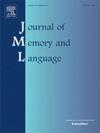Measurement and sampling noise undermine inferences about awareness in location probability learning: A modeling approach
IF 3
1区 心理学
Q1 LINGUISTICS
引用次数: 0
Abstract
Occasionally, experimental psychologists enter into the realm of psychometrics without being fully aware of the risks involved in the study of individual differences. Here we re-assess the many studies on the interaction between memory and attention in location probability learning that suggest that people can unconsciously learn to suppress salient but irrelevant distractors frequently presented in a certain location. In the additional singleton task, one of the arguments to support this claim is that suppression in memory-guided visual search does not significantly differ between “aware” and “unaware” participants. Although rarely acknowledged, this null interaction could also result if the data are contaminated by measurement and/or sampling noise. Unfortunately, the reliability of the awareness measure cannot be assessed with standard methods, since it is a single-trial test. In the present study we offer model-based estimations of measurement and sampling noise in empirical data. Our goal is to determine how often researchers would mistakenly conclude that learning is unconscious, given data from a model based on the opposite claim (i.e., that learning is conscious) but including noise in participants’ search times and awareness responses. To do so, we fitted this noisy conscious model to a dataset involving 159 participants who performed the additional singleton task. Estimated parameters from this model were used, first, to predict the observed pattern of results and, second, to simulate new responses and participants. Results suggest that, under reasonable measurement noise and sample sizes, simulated evidence from the model can paradoxically but falsely support arguments used to defend the unconscious learning hypothesis. This study serves as an illustration to experimental psychologists – particularly those investigating memory and learning – of the risks of neglecting basic psychometric requirements in individual differences research.
测量和采样噪声破坏了位置概率学习中关于意识的推论:一种建模方法
偶尔,实验心理学家在没有充分意识到个体差异研究所涉及的风险的情况下进入心理测量学领域。在此,我们重新评估了许多关于位置概率学习中记忆和注意之间相互作用的研究,这些研究表明人们可以无意识地学习抑制在特定位置经常出现的显著但不相关的干扰物。在额外的单例任务中,支持这一说法的一个论据是,在“有意识”和“无意识”的参与者之间,记忆引导的视觉搜索的抑制并没有显著差异。虽然很少有人承认,但如果数据受到测量和/或采样噪声的污染,也可能导致这种零相互作用。不幸的是,意识测量的可靠性不能用标准方法来评估,因为它是一个单试验测试。在本研究中,我们提供了基于模型的测量和采样噪声的估计经验数据。我们的目标是确定研究人员错误地得出学习是无意识的结论的频率,给出的数据是基于相反的主张(即,学习是有意识的),但包括参与者搜索时间和意识反应中的噪音。为此,我们将这个嘈杂的意识模型拟合到一个包含159名参与者的数据集上,这些参与者执行了额外的单例任务。该模型的估计参数首先用于预测观察到的结果模式,其次用于模拟新的反应和参与者。结果表明,在合理的测量噪声和样本量下,该模型的模拟证据可以矛盾地但错误地支持用于捍卫无意识学习假说的论点。这项研究为实验心理学家——尤其是那些研究记忆和学习的心理学家——提供了一个例证,说明在个体差异研究中忽视基本心理测量要求的风险。
本文章由计算机程序翻译,如有差异,请以英文原文为准。
求助全文
约1分钟内获得全文
求助全文
来源期刊
CiteScore
8.70
自引率
14.00%
发文量
49
审稿时长
12.7 weeks
期刊介绍:
Articles in the Journal of Memory and Language contribute to the formulation of scientific issues and theories in the areas of memory, language comprehension and production, and cognitive processes. Special emphasis is given to research articles that provide new theoretical insights based on a carefully laid empirical foundation. The journal generally favors articles that provide multiple experiments. In addition, significant theoretical papers without new experimental findings may be published.
The Journal of Memory and Language is a valuable tool for cognitive scientists, including psychologists, linguists, and others interested in memory and learning, language, reading, and speech.
Research Areas include:
• Topics that illuminate aspects of memory or language processing
• Linguistics
• Neuropsychology.

 求助内容:
求助内容: 应助结果提醒方式:
应助结果提醒方式:


